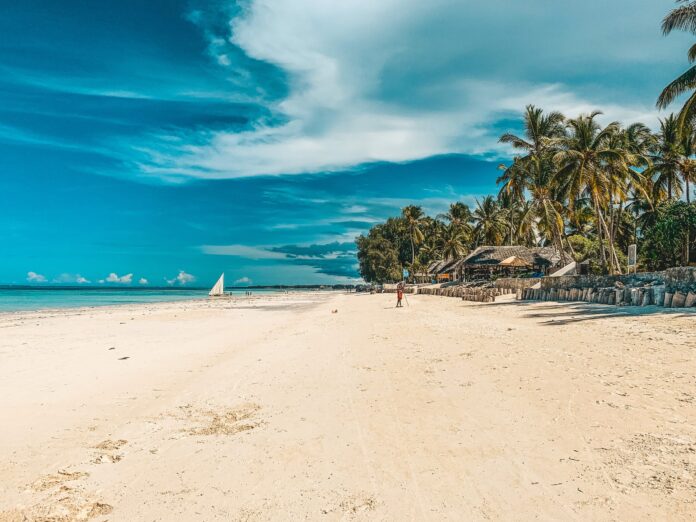One of life’s greatest travel indulgences, an African safari can take years to organize. Since it requires a hefty budget, a couple of grueling days in transit and meticulous planning, chances are it will be a once-in-a-lifetime adventure you enjoy — and one you therefore shouldn’t compromise on.
The safari component is generally less than five days for most travelers, leaving plenty of time to combine superb wildlife watching and a classic lodge experience with further exploration or relaxation. For some, this could also involve climbing Mount Kilimanjaro in Tanzania or visiting Victoria Falls on the Zambia-Zimbabwe border. For others, it may entail wine tasting in South Africa or lazing on a pristine, palm-fringed beach with a cocktail in hand.
When it comes to blissed-out safari extensions, the Indian Ocean offers a few key commodities: undeveloped beaches, spectacular scenery, azure waters rich with marine life — and an abundance of luxurious resorts, including ones you can book with points.
Sign up for our daily newsletter
Africa isn’t the easiest place to get around, but that doesn’t mean it isn’t possible to see multiple destinations in one visit. All it will take is a little careful planning. Odds are you’ll be required to fly way out of your way to major regional hubs such as Johannesburg’s O.R. Tambo International Airport (JNB) or Nairobi, Kenya’s Jomo Kenyatta International Airport (NBO).
While most safari-goers head to the beach to unwind at the end of their trip, there’s also something to be said for decompressing from city life and a long-haul flight by adding the beach as a safari preamble. Regardless of which you choose to do first, know that you’ll have an incredible vacation full of memorable moments.
Here are TPG’s favorite destinations for that ultimate combination of going on safari and visiting the beach.
For more TPG news delivered each morning to your inbox, sign up for our daily newsletter.
Tanzania
Bush: The Northern Circuit
Famed for its untouched landscapes and exhilarating wildlife encounters, Tanzania’s Northern Circuit is the Africa of dreams. A showcase for the continent’s highlights, this well-trodden itinerary features the world-famous Serengeti, snow-capped Mount Kilimanjaro, elephant-filled Tarangire National Park and Ngorongoro Crater, the world’s largest intact volcanic caldera.
Arusha is the gateway to the northern Serengeti, as it’s a two-hour flight from the capital, Dar es Salaam. Depending on time and budget constraints, you can either fly between the parks, drive the entire circuit or do a combination of both.
Most itineraries begin with the Serengeti, Tanzania’s crown jewel. Emblematic grasslands dotted with flat-topped acacia trees are home to more than 2 million animals, including the Big Five: lions, leopards, rhinos, elephants and African buffaloes. Indulge the wonder of it all at a luxury lodge within eyeshot of a watering hole, or head to a semi-permanent tented camp that follows the great migration. In the remote Lamai Triangle, Singita Lamai River Tented Camp offers an intimate, off-the-grid safari experience and features just six luxurious tents, each with plunge pools.
A game drive along the valley floor of Ngorongoro Crater — around a three-hour paved drive south of the Serengeti — is one of the richest wildlife experiences on Earth. More than 25,000 mammals thrive here, including the world’s largest concentration of predators, plus zebras, gazelles, warthogs, wildebeests, elephants, baboons and vervet monkeys. Within the conservancy, you can trace 2 million years of human evolution at the UNESCO-inscribed Olduvai Gorge, which preserves the earliest evidence of human ancestors.
Around a four-hour drive south of the crater is another must-visit spot: beautiful Tarangire National Park. It attracts fewer visitors and is beloved for its thriving elephant herds, which feature 2,500-plus animals, making them the densest on Earth.
Related: Dreaming of an African safari: How I’ll book my bucket-list trip to Tanzania on miles and points
Safari vehicles with tourists in between large herds of Wildebeest (Gnu, Connochaetes) and Zebras (Equus quagga, formerly Equus burchelli) inside world famous Ngorongoro Crater. Location: Ngorongoro Conservation Area, Northern Tanzania. Shot in wildlife. GUENTERGUNI/GETTY IMAGES
Beach: Zanzibar
A breathtaking archipelago just 25 miles off Tanzania’s Indian Ocean coastline, Zanzibar is everything its name suggests. Traditional dhows (one- or two-mast ships) set sail from bone-white beaches, vibrant coral reefs support diverse marine life and timeless Swahili villages are fringed by lush forests, coconut groves and spice plantations.
Zanzibar is one of the most accessible beach destinations on this list, with frequent direct services from Arusha via Air Tanzania. If you are traveling independently, the one-hour flight from the mainland costs around $180 round trip.
Relaxing on its beaches is certainly Zanzibar’s main draw, but it’s worth allowing at least a day to explore UNESCO World Heritage-listed Stone Town, one of East Africa’s cultural highlights. A flourishing trading post for centuries, the old city’s maze of streets is dotted with crumbling limestone and coral buildings, as well as historical churches, mosques and temples.
Just a 15-minute speedboat ride off Zanzibar’s northeast coast, Mnemba Island is an unpretentious paradise. The tiny island, blessed with powder-soft sand and luminescent waters, is the setting for andBeyond’s conservation-focused hideaway. Getting off the grid doesn’t get much better than this. Days are spent snorkeling around the island (about a mile in circumference), swimming with dolphins, practicing yoga, paddleboarding, watching dik-diks scurry around the deck of your Balinese-style banda and enjoying some of the finest and most inventive food you’ll find anywhere in Tanzania.
Tanzania, Zanzibar Archipelago, Unguja island (Zanzibar), dhow (local boat) passing Bowe island or Prison island. BRUNO MORANDI/GETTY IMAGES
Kenya
Bush: Masai Mara
The definitive safari destination, Kenya offers a blend of savannah, mountain, wildlife, beach and culture that never fails to inspire awe in those who visit.
The spectacular Masai Mara ecosystem forms the northern extension of Tanzania’s Serengeti. A cinematic wilderness of tawny, acacia-dotted plains, the food chain plays out frequently and furiously right before your eyes. Home to a vast inventory of 450-plus animal species (including the Big Five) and glorious scenery, Kenya’s popularity has been bolstered by post-pandemic travelers keen to limit border crossings.
For a less crowded safari experience, choose a lodge located on a private conservancy that offers opportunities to venture off roads (sometimes at night) in the company of expert naturalists without worrying about waiting behind multiple vehicles to view a pride of lions. Cottar’s Camp has been in operation for over a century and combines a classic aura with luxe amenities and some of Kenya’s finest (largely Masai) guides. Wherever you roam, you can expect to see prolific troupes of wildebeests, zebras, impalas, topis and gazelles — and their formidable predators.
While all safari lodges are not created equal, it’s the daily rituals of life on the Masai Mara that are unforgettable. You can enjoy an early morning game drive, watch elephants congregate around a watering hole from your deck, treat yourself to a sundowner as sunsets blaze over the seemingly infinite horizon and gather around a campfire under star-studded skies.
Try to time your trip for the great migration, when more than 2 million wildebeests migrate across the Serengeti and the Masai Mara in what is undoubtedly the world’s most spectacular wildlife event. Keep an eye on rainfall patterns to determine when is the best time to visit.
Related: Everything you need to know about going on safari in Africa with renowned expert Marlon du Toit
Group of Maasai warriors going back to village, central Kenya, Africa. Mount Kilimanjaro on background, Southern Kenya, Africa. Maasai tribe inhabiting southern Kenya and northern Tanzania, and they are related to the Samburu. HADYNYAH/GETTY IMAGES
Beach: Lamu Island
Often likened to Zanzibar 20 years ago, UNESCO-protected Lamu Island is a picture-perfect paradise of rolling sand dunes, mangrove-fringed beaches and dazzling coral reefs. As East Africa’s oldest trading center, it’s a world apart from the rest of Kenya and offers a more peaceful retreat than the more developed beaches of Mombasa’s north coast.
In the south, Lamu Town has preserved its medina-style architecture and retains a laid-back vibe. Donkeys and dhows are still the main forms of transportation, and the town’s car-free streets, which are dotted with churches, mosques and temples, showcase the island’s rich cultural heritage composed of African, Omani, Yemeni, Indian and Portuguese influences.
Over the last decade, Lamu has become something of a magnet for Europe’s celebrity set. Intricately carved coral merchant homes now house contemporary boutique hotels and galleries, hip rooftop bars mix stylish sundowners and a busy event schedule speaks to the island’s growing wellness movement — notably yoga and meditation retreats.
Just outside Lamu Town, The Red Pepper House has five eclectic rooms decorated with Swahili furnishings, a lush forested setting, warm service and activities tailored to each guest.
Active travelers will also find plenty here to tempt them from the beach. Check out Kiwayu Island for windsurfing, kayaking, fishing and world-class diving and snorkeling.
If you are traveling independently, Lamu can be reached by air from Nairobi via Hahn Air Lines. Flights, which cost $190 round trip, land just across the channel from Lamu on Manda Island.
Lamu is East Africa’s best-preserved Swahili settlement. TUUL & BRUNO MORANDI/GETTY IMAGES
South Africa and Mozambique
Bush: Kruger National Park
Impressive in scale and diversity, Kruger’s 16 macro ecozones harbor an astonishing predator count — more than 1,500 lions, 1,000 leopards and 12,000 elephants — as well as wild dogs, zebras, white and black rhinos, giraffes, wildebeests, antelopes and an estimated 470 bird species.
The great appeal of Kruger — especially for first-timers — is its reliable wildlife spotting (even during the green season), unbridled comfort and never-ending “wow” factor that exhilarates even the most world-weary traveler.
When money is no object, the Sabi Sands Game Reserve is the pinnacle of the luxury safari experience. Home to the highest mammal concentration of any private reserve in southern Africa, you won’t need to venture far to spot Africa’s most charismatic denizens. In fact, it’s not unheard of to spot all of the Big Five at Kruger in the space of a day. With only three vehicles permitted at a wildlife sighting at any given time, you’ll avoid the feeling that you are riding a safari conveyor belt.
Acclaimed lodges such as Singita Lebombo, Chitwa Chitwa and Londolozi channel eclectic styles — from plush colonial suites to rustic Afro-chic abodes — and are constantly raising the bar with impeccable service, resort-style amenities and unrivaled access to some of Earth’s best wildlife viewing. Lavish meals, sundowners, afternoon teas, poolside relaxation and bush walks punctuate the hours between early morning and late afternoon game drives. Many of Kruger’s lodges also offer excellent children’s programming.
Related: Safaris, cities and lots of elephants: How I returned to South Africa this year using points, miles and cash
The luxurious Chitwa Chitwa private game lodge is located within the Sabi Sands Game Reserve on the border of Kruger National Park. MARTIN HARVEY/GETTY IMAGES
Beach: Bazaruto Archipelago
Blessed with unspoiled natural beauty and impressive biodiversity, Mozambique’s Bazaruto Archipelago offers the private island kind of experience that appeals to travelers with deep pockets who are looking to truly disconnect. For most visitors, the logistics are taken care of as part of a tailor-made, fly-in excursion arranged by a safari company.
Bazaruto and its even more far-flung sister archipelago, the Quirimbas Islands, are renowned for their serpentine, palm-fringed beaches where the diving and snorkeling, right offshore, are out of this world. An array of marine life, including whale sharks, manta rays, leatherback turtles, humpback whales and the very rare dugong (sea cow), has been documented here.
With activities and excursions tailored to couples and families, andBeyond’s Benguerra Island Lodge is a destination unto itself. It offers luxurious beachfront casinhas (cottages) and cabanas surrounded by palm trees. Guests can take advantage of a swimming pool and an on-site dive center that organizes excursions to world-class dive sites like Two Mile Reef, plus other unforgettable activities, such as dhow cruises, horseback riding in the water and sportfishing excursions.
Frequent daily direct flights with South Africa-based Airlink are available from Johannesburg’s airport to Mozambique’s Vilankulo Airport (VNX), which sits about a 45-minute scenic boat ride away from the Bazaruto islands. The relatively painless, half-day journey will set you back around $580 round trip.
Bazaruto, Mozambique. WATEROTTER/GETTY IMAGES
Malawi
Bush: Majete Wildlife Reserve
Going by the moniker “The Warm Heart of Africa,” tiny Malawi punches way above its weight when it comes to biodiversity.
Roughly the same size as Ohio, it’s home to some of the continent’s most spectacular landscapes, which span serrated peaks, mystical forests and bucolic grasslands. The Great Rift Valley bisects the country lengthwise, with the colossal Lake Malawi draped across the country’s eastern border.
Malawi’s lack of celebrity status helps facilitate a more authentic safari experience. It’s also one of the most affordable and safest destinations in Africa — a great fit for independent travelers looking to go beyond the “Out of Africa” cliches.
Before a major legislative shake up in 2017, Malawi had earned the notorious distinction of being southern Africa’s biggest wildlife trafficking center, mostly due to lax enforcement. Today, its conservation credentials are among the strongest in Africa.
Majete Wildlife Reserve, the nation’s oldest park, is a symbol of Malawi’s great restoration. Through a steady re-introduction program and community engagement, more than 5,000 animals now thrive within the reserve, including black rhinos, impalas, jackals, elephants, lions, leopards, cheetahs, wild dogs, sable antelopes and buffaloes. Enjoying Big Five reserve status, tourism at Majete is growing, but it remains a magical off-the-beaten-path wilderness … for now.
The upscale Thawale Camp is ideally located near a watering hole inside the reserve and combines a wilderness safari experience with an authentic ambience, fine food and warm service.
Related: TPG readers’ best tips for visiting Africa on points and miles
Impalas and waterbucks in Majete Wildlife Reserve. BRYTTA/GETTY IMAGES
Beach: Lake Malawi
Described as the world’s most vibrant freshwater body, UNESCO-designated Lake Malawi is a perfect safari postscript for more budget-minded travelers and those making a return trip to the continent. It offers all the attributes of an idyllic island escape with beautiful bays and coves, sandy beaches and rocky islands, plus marshes inhabited by baboons, monkeys, hippos and prolific birdlife, including kingfishers, egrets, fish eagles and cormorants.
Free from the logistical challenges of many bush-to-beach itineraries, it’s just a one-hour transfer from Malawi’s Kamuzu International Airport (LLW) to the lake’s most scenic beaches, including chilled-out Likoma Island, where you’ll find barefoot-chic Kaya Mawa, a boutique ecolodge perched on sandy shores with views of Mozambique in the distance.
The water here is as blue as any tropical destination, and even shallow water teems with cichlid fish, which shimmer in hues of silver, gold, orange and blue. The lake’s three distinct water layers don’t generally mix (it’s a type of meromictic lake), providing an intensely fertile environment where plants, land animals and marine life thrive.
An estimated 950 species of fish populate the lake — more than any other place on Earth — according to the beloved British naturalist David Attenborough. This rich aquatic atmosphere makes it a truly unique underwater safari destination. The real crowd-pleaser is the mbuna fish, which will famously take food directly from your hands.
Chitimba, Lake Malawi. MARIA SWÄRD/GETTY IMAGES
Zambia and Mauritius
Bush: South Luangwa National Park
Victoria Falls, which is lovingly referred to as “the smoke that thunders” by those from the area, is Zambia and Zimbabwe’s famous calling card and one of the world’s most breathtaking natural wonders. But that’s just the start. Far removed from the more commercial safari experiences of its neighbors, the two countries lend themselves to travelers keen to explore beyond their safari vehicles. The region excels at immersive cultural journeys, walking safaris and adrenaline-infused pursuits on the churning rapids of the Zambezi River.
Know, though, that Zambia and Zimbabwe are not for everyone. Their poor infrastructure and limited accommodations can be a challenge or an adventure, depending on your perspective.
Zambia’s South Luangwa National Park is the place where the walking safari originated. Diverse habitats encompass plains, woodlands, rivers and marshes and support a predator and prey inventory that rivals that of any African safari destination. The pinnacle of wildlife viewing in Zambia, Luangwa is known for its leopard population, as well as rare creatures such as hartebeests, sables and roans. Buffaloes, impalas, pukus, waterbucks and giraffes are omnipresent, and herds of elephants (up to 70 is not unheard of) and wading hippos can be seen congregating along the Luangwa River.
One of the more luxurious camps in the reserve, Chinzombo, offers comfortable accommodations, expert guides and a prime river location.
South Luangwa National Park is the original home of the walking safari. STUART FOX/GETTY IMAGES
Beach: Mauritius
One of the most alluring Indian Ocean destinations, Mauritius is much more than just a dreamy island paradise. Gorgeous beaches, crystal-clear lagoons and forested preserves provide the backdrop for thrilling adventures, ecotourism and wellness pursuits. For a culture fix, the museums and mansions of Port Louis are filled with fascinating artifact maps and curios that trace the island’s storied history.
Belle Mare beach, on the east coast, has retained its unspoiled charm. Its warm, azure waters beckon snorkelers and divers, as Mauritius is ringed by the world’s longest unbroken coral reef. With its string of luxe resorts, hip bars and gourmet restaurants, the developed resort of Grand Baie, on the northwest coast, channels a more cosmopolitan vibe.
Active types will find plenty of ways to interact with the rugged, mountainous landscape. Hikers can take on the 4.5-mile steep, uneven trail to the top of the UNESCO-inscribed Le Morne Brabant mountain. Meanwhile, the coastal forests of Île aux Aigrettes provide sanctuary to an array of endemic and endangered wildlife species.
You will likely spend a day in transit to reach Mauritius from Zambia, and you may even require an overnight layover. There are regular nonstop flights from Kenneth Kaunda International Airport (LUN) in Lusaka, Zambia’s capital, to Johannesburg, from where its a four-hour flight — operated daily by South African Airways — to Mahé, Mauritius’ main island.
Mauritius caters well to travelers looking to splurge and you”ll be spoiled for choice when it comes to exclusive resorts and private island experiences: The Four Seasons Resort Mauritius at Anahita, Shangri-La Le Touessrok and One&Only Le Saint Géran, to name a few.
Related: Why Mauritius should be at the top of your travel to-do list right now
Mauritius combines blissful beaches with outdoor adventure and cultural excursions. PB57PHOTOS/GETTY IMAGES
Namibia and the Seychelles
Bush: Etosha National Park
An accessible and less visited safari destination, Namibia captures the imagination of families and adventure seekers with its enigmatic desert landscapes, wild and rugged coastline, colossal sand dunes and rare desert-adapted mammals, insects and reptiles.
Known as the “Place of Mirages,” Etosha National Park combines Namibia’s best wildlife watching with an austerely beautiful landscape of golden plains, dazzling salt pans and dense thickets. What really sets Etosha apart, though, is just how easy it is to spot its wildlife species.
Across stark, vast plains, watering holes draw elephants, gazelles, giraffes, jackals and black and white rhinos, as well as marauding lions, cheetahs and more elusive leopards. The floodlit Okaukuejo watering hole ranks among Africa’s bucket list experiences thanks, in part, to its nightly game-watching vigils.
Antelope species here are loaded with superlatives: You’ll find the continent’s smallest (African antelope), rarest (blackface impala), biggest (eland) and bounciest (springbok) all inhabiting this eye-catching landscape.
Located on Etosha’s southern fringes, in the privately owned Ongava Game Reserve, Ongava Lodge comprises 14 rustic chalets and a large pool and dining area overlooking a nearby watering hole. Little Ongava — also within the private reserve — offers a more exclusive experience with just three luxurious suites with outdoor showers and private plunge pools.
Beyond Etosha, thrill-seekers can track wildlife on foot, sandboard down massive dunes in Swakopmund and soar over the Namib Desert in a hot air balloon.
Namibia is celebrated for its bold conservation initiatives and well-developed tourist infrastructure. While it’s one of the most straightforward destinations in Africa for renting a car and exploring independently, guided tours here are considered the gold standard. Most travelers from Europe and the U.S travel to Namibia through Johannesburg or Cape Town. Air Namibia flies direct from Frankfurt to Windhoek, and Qatar Airways’ direct flights to Doha, Qatar, offer frequent stopover routes to the U.S. and Europe.
Related: How to have a royal-inspired honeymoon in Namibia with points and miles
Etosha’s startling salt pans make it easier to spot resident wildlife such as baby black rhinos. JOHAN63/GETTY IMAGES
Beach: Seychelles
Famed as a luxury hideaway popular with royalty and celebrities, the Seychelles archipelago has an otherworldly beauty. Ribbons of sugar-white sand gently slope to waters in every shade of blue, and tropical habitats filled with rare indigenous palms give way to vanilla and spice plantations and orchid fields.
The most visited islands, Mahé, Praslin and La Digue, draw gilded honeymooners to their ultra glamorous resorts — including a luxurious Four Seasons outpost and the boutique Mango House Seychelles — but there’s also a fine selection of family-oriented properties (including points hotels) within striking distance of breathtaking beaches.
Anse Lazio frequently ranks as one of the world’s best beaches; its turquoise, reef-sheltered waters teem with marine life. Lushly forested granite cliffs frame the sheltered bay of Anse Louis, one of Mahé’s more remote beaches, and it was on heavenly Anse Source d’Argent that Hollywood movies “Cast Away” and “Crusoe” were filmed.
Uninhabited until the late 18th century, the Seychelles archipelago is hailed as the “Galápagos of the Indian Ocean.” UNESCO-inscribed Vallée de Mai Nature Reserve on Praslin is a lost world of rare endemic species, including the famous coco de mer, a massive palm tree thought to have grown in the ocean. On the remote Aldabra atoll, thousands of giant tortoises weighing up to 500 pounds thrive, having evolved in isolation.
From Namibia’s capital, Windhoek, you’ll need to connect through Johannesburg. Air Seychelles is the only airline that flies the five-hour, nonstop route to Mahé several times a week.
Related: From the Serengeti to the Seychelles: Honeymooning at 2 stunning Four Seasons resorts
The world’s most famous castaway beach is perhaps Anse Source d’Argent in the Seychelles. ALXPIN/GETTY IMAGES
FEATURED IMAGE BY SERGEJ ROSLIKOV/EYEEM/GETTY IMAGES










